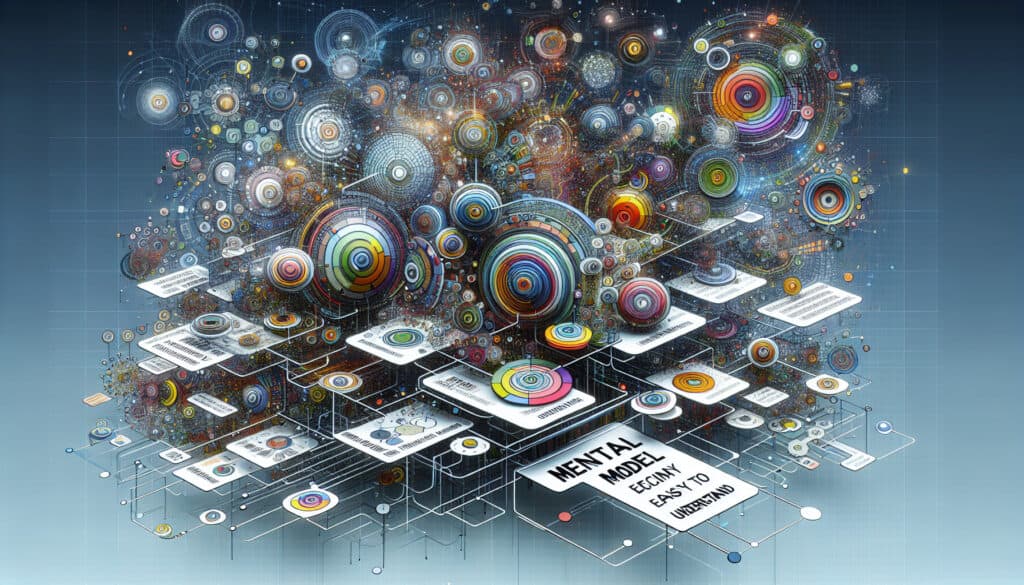Visualizzare la comprensione di un sistema o di un processo da parte dell'utente.
- Metodologie: Lean Sigma, Produzione, Risoluzione dei problemi, Qualità
Diagrammi del modello mentale

Diagrammi del modello mentale
- Esperienza del cliente, Processo di progettazione, Pensiero progettuale, Human-Centered Design, Design dell'interazione, Usabilità, Test di usabilità, Esperienza utente (UX), Progettazione incentrata sull'utente
Obiettivo:
Come si usa:
- Un diagramma che rappresenta il sistema di credenze dell'utente sul funzionamento di un prodotto o di un sistema. Aiuta i progettisti a capire le aspettative dell'utente e a progettare un prodotto più intuitivo e facile da usare.
Professionisti
- Aiuta a progettare prodotti più intuitivi e facili da usare; può identificare le aree in cui il modello mentale dell'utente differisce dal sistema reale.
Contro
- La creazione può richiedere molto tempo; i risultati si basano su un piccolo campione di utenti e potrebbero non essere rappresentativi.
Categorie:
- Clienti e marketing, Progettazione del prodotto
Ideale per:
- Progettare una nuova applicazione software o un sito web per renderlo più intuitivo e facile da usare.
Mental Model Diagrams can be effectively applied in various project phases, particularly during the early stages of product development when understanding user perceptions and expectations is paramount. Typically used in industries such as software development, web design, and consumer electronics, these diagrams allow design teams to visualize how users conceptualize the operations and features of a system. Participants in this process should include product designers, UX/UI specialists, and stakeholders who have a deep understanding of the target audience, making it imperative to gather qualitative data through user interviews or usability testing. By mapping out users’ beliefs and assumptions about a product, design teams can pinpoint discrepancies between the user’s mental model and the actual workings of the system, which may lead to usability issues. This methodology can be particularly beneficial in industries that require complex system interactions, such as healthcare technology or finance, where a clear understanding of user expectations can significantly enhance user satisfaction and adoption rates. An example application could be creating an e-commerce platform where customers have specific expectations about checkout processes. If designers can visualize user assumptions, they can design a smoother, more predictable experience that caters to user expectations, thereby increasing conversion rates and reducing cart abandonment. Through this collaborative approach, teams can ensure that their final product reflects user needs more accurately, ultimately leading to a more engaging and user-friendly experience.
Fasi chiave di questa metodologia
- Identify user tasks and goals related to the product or system.
- Create a high-level overview of the system’s functionality as perceived by users.
- Map out the user’s beliefs and expectations regarding how the product works.
- Compare user mental models with the actual system functionalities.
- Identify discrepancies and areas for improvement in design and usability.
- Refine design concepts based on findings from the mental model analysis.
- Iterate on the design with user feedback, ensuring alignment with user expectations.
Suggerimenti per i professionisti
- Conduct user interviews to uncover latent mental models that may not be immediately apparent; this can guide design choices that align closely with user expectations.
- Utilize card smistamento methods to understand how users categorize information, which can inform navigation structures and labeling conventions.
- Create iterative prototypes and conduct usability testing focused on specific mental model assumptions; observe where users struggle to align their expectations with the interface.
Leggere e confrontare diverse metodologie, raccomandiamo il
> Ampio archivio di metodologie <
insieme ad altre 400 metodologie.
I vostri commenti su questa metodologia o ulteriori informazioni sono benvenuti su sezione commenti qui sotto ↓ , così come tutte le idee o i link relativi all'ingegneria.
Contesto storico
1986
(se la data non è nota o non è rilevante, ad esempio "meccanica dei fluidi", viene fornita una stima approssimativa della sua notevole comparsa)

Post correlati
Simulazione di Monte Carlo
Test basati su modelli
Controllo del modello
Ricerca con metodi misti
A prova di errore (Poka-Yoke)
Test del profilo di missione